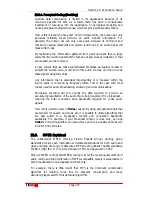
Section 22: Connection Setup
T
ieline
T E C H N O L O G Y
Page 209
22.9.2.
Artifacts and Cascading, what should I be aware of ?
Artifacts are the enemy of the codec broadcaster. Artifacts are to a certain
extent introduced by quantization in data compression and may be inaudible
at low levels. When audible they can sound ’ hissy’, ‘grainy’, ‘metallic’ or like
‘warbling’. Artifacts may become audible when caused by a variety of factors
such as:
Overly aggressive compression rates;
Packet errors or loss of packets from a bit stream;
Loss of sync (i.e. AES/EBU connections); or
Cascading the audio signal.
Cascading is when an audio signal is processed through more than one
codec. The effects of cascading through multiple codecs may evidenced by
increases in artifacts and their audibility. This is particularly noticeable with
‘lossy’ codecs, which reduce source audio data by nature.
The best way to avoid cascading artifacts is to choose the highest bit rate
possible for your codec connection. In addition, plan for your end-to-end
broadcast chain to include the least amount of signal compression and
cascading as possible.
To listen to an example of quantization noise, visit
http://en.wikipedia.org/wiki/Quantization_noise and download the audio file
available from this website.
22.9.3.
Which Algorithm is best for my Broadcast Situation?
In general, it is a question of what connection quality can be achieved
depending on the connection bit rate available. It may also be a question of
trying to be compatible with other equipment. In this section we will provide
you with some rule-of-thumb settings for how to configure your codec –
depending on the broadcast situation you are faced with. Here is your
connection checklist:
What is the connection bandwidth available on my connection?
How stable is the bit rate likely to be on this connection over time?
Will I be sending music, voice, data or a combination of these
elements?
Will I be broadcasting live and if so will I be requiring communications
with the studio?
The algorithm you connect with will be dependent on the program audio you
are sending and the connection bit-rate you are able to achieve. For example,
Music
is generally the preferred POTS algorithm setting if your program
content contains music.
Voice G3
is generally best to use for a POTS
connection if your connection bit-rate is 16,800 bps or lower.
One of the unique features of the
T
ieline
Music
algorithm is its ability to send
a 15 kHz stereo audio signal over a single B-channel, with a delay of only 70
ms… pretty impressive huh!
Содержание i-Mix G3
Страница 41: ...Section 7 Quick Start Tieline Page 41 T E C H N O L O G Y 7 3 5 3G Wizard Figure 12 3G Wizard...
Страница 42: ...Section 7 Quick Start Tieline Page 42 T E C H N O L O G Y 7 3 6 New X 21 Wizard Figure 13 X 21 Menu Wizard...
Страница 116: ...Section 15 Operation of your Codec Tieline T E C H N O L O G Y Page 116 Figure 29 Menu Submenus...
Страница 119: ...Section 15 Operation of your Codec Tieline T E C H N O L O G Y Page 119 Figure 30 Configuration Submenu Items...
Страница 344: ...Appendix 1 Connector Wiring Tieline T E C H N O L O G Y Page 344 Appendix 1 10 CAN Cable Wiring Configuration...
Страница 350: ...Appendix 5 Codec Specifications Tieline T E C H N O L O G Y Page 350 Appendix 5 Codec Specifications...
















































